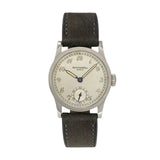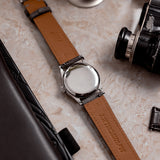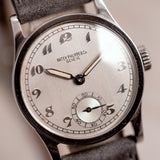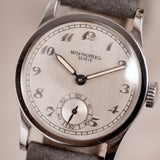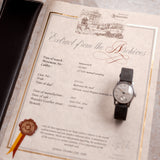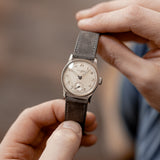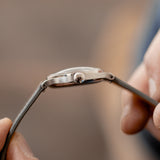Patek Philippe Calatrava 96 steel with raised Breguet numerals
Origin
It is widely regarded that Patek Philippe has occupied the top of the horological tree for centuries. Remaining family owned ever since its inception in 1839, Patek has always prided itself on simply producing some of the greatest watches the world has ever seen. The brand has always had an eye for traditional, sophisticated, and mechanically mind-blowing creations. Due to a combination of the aforementioned as well as low production numbers on specific references, they have a plethora of highly collectable and exceedingly rare watches often dominating auction room headlines. This haute horology watchmaker has a history of firsts under its belt including producing the first perpetual calendar wristwatch (1925), the first perpetual calendar chronograph (1941), the first sweeping second’s perpetual calendar wristwatch (1944), and the first self-winding perpetual calendar (1962). Whatever the type of watch Patek Philippe turns its hand to, excellence follows.
Despite their accolades when it comes to complicated pieces, Patek Philippe also has an extensive archive of effortlessly elegant simplistic timekeepers with one creation so iconic its name has gone on to become synonymous with the whole genre: the Calatrava. During the early part of the 20th century, Patek Philippe was struggling. Regardless of their various achievements and prestigious reputation, the brand needed a saviour both in the shape of new owners and a new model with a broader degree of market appeal. As such the reference 96 Calatrava was born. A reference that focused on remaining understated, refined, and widely appealing, this model is widely regarded as the piece which laid out the blueprint for dress watches with its stripped-back Bauhaus inspired design and compact proportions. The 96 remained in production for 40 years until the 1970s resulting in a huge amount of different configurations being produced. Some feature small nuances such as a different handset or a dial tweak, whereas some include a different metal for the case, extremely distinctive dial furniture, and even different or sometimes no seconds hand. As such each of these unusual configurations carry with them significant provenance.
The Calatrava continues to be an important part of the Patek Philippe operation and as recently as 2021 the Calatrava received a newly updated refresh. 90 years later, despite decades of evolving watch design, the essence of the 96 hasn’t been lost. This evolution has only made the original that much more appealing and sought after.
The Watch
Produced just ten years after the model was first introduced, this Patek Philippe Calatrava 96 is something truly special. Originally conceptualised in gold, the 96 was produced in an array of case materials including, in very small amounts, stainless steel. Also conceptualised for the model’s birth were large dauphine styled hands and a dial featuring large applied gold baton markers. This 96 represents a completely different variation of its initial design with a configuration believed to have only been produced in less than 10 examples. Measuring 31mm in width, the externals of this 96 are complete in stainless steel featuring the defining flat bezel, rounded caseback, and thick wide lugs which barely taper from the complete width of the piece. The lugs of the 96 were integrated into the three part construction of this now hugely noteworthy case rather than just being soldered on like other watches at the time. This approach may now be common practise, but at the time it allowed the 96 to carry a level of coherence and refinement that speaks so closely to the Patek Philippe ethos.
As alluded to earlier, the dial is arguable the most compelling aspect of this specific 96 as it carries some seriously desirable furniture. It starts with its canvas which is complete in a silver tone and is presented in original, untouched condition; versatile in 1944 just as much as it is today. Then things start to get a little special as a railroad track surrounds and frames the watch featuring perfect luminous plots at each hour position. Luminous plots are only useful if luminous hands are present and in this case, a stunning set of syringe hands take command, a style which occupies that sweet spot between rugged practicality with a sprinkling of elegant class. It’s worth noting that the luminous material throughout the watch that was once highly radio-active radium has since been safely replaced by Patek Philippe themselves.
Sitting at the six o’clock position is a concentric circle filled sub-register keeping track of each passing second via a petit thermally blued leaf hand. With 10-60 housed externally of the sub-register complete with a railroad track and a sector like styling, the narrative of a slightly more rugged, almost militaristic 96 design is effectively conveyed. That is until the numerals on this piece come into play. It seems to be the unspoken rule in horological appreciation that Breguet numerals are regarded as the most whimsical, heart-warming set a watch dial is lucky enough to possess, and here, this 96 is one of those lucky few. Raised and presented in stainless steel to match the case, these large Arabic numerals paint the 96 in a different yet undeniably appealing light.
This is something that is emphasised further by its mechanical beating heart…
The Movement
Powering this important petit Patek Philippe is the in house calibre 12-120. Taking the brand’s movement production in house was a key components of the Stern families impact on Patek Philippe and such further elevated and cemented the brand’s reputation going forward. With a design and decoration evoking the work seen in their pocket watches, the 12-120 features all manner of compelling aspects such as its flowing wave shaped bridges with beautiful anglage, Geneva striping throughout, swan-neck regulator, and optimal wheel placement.
In true Patek Philippe fashion, despite this movement beating away behind a solid caseback it retains a high level of finishing and of course, a favourable performance.
How It Wears
There is a reason why many regard the 96 as the defining language for a dress watch. Its width is understated, minimal and unassuming at 31mm, carrying a slenderness to match. Thanks to its strong lugs however, the watch does manage to incorporate a sense of intent on the wrist. Its inclusion of syringe hands somehow manage to inject further character and the use of Breguet numerals are a pure delight to look at with every wrist check. Although its smaller size may initially put some off, once the importance of the piece is appreciated its 31mm case size feels nothing short of perfection.
Condition
This 96 from Patek Philippe was manufactured in 1943 and first sold in 1944. The dial is presented in original condition with the luminous material throughout the watch that was once highly radio-active radium being safely replaced by Patek Philippe themselves. The case is in a very honest condition and doesn’t possess any evidence of overpolishing. Complete with an extract from the archive directly from Patek Philippe as well as the original Patek Philippe steel buckle. This 96 is sold fitted to a Mr Watchley watch strap.
If you desire to take a closer look at this precious timepiece, don't hesitate to contact us and make an appointment. We are based in Ghent, Belgium
No stock kept on site.
| Reference | 96 |
|---|---|
| Movement | Manual Wound |
| Caliber |
Calibre
12-120
|
| Dial | Silver |
| Size (Case) | 31mm |
| Material (Case) | Steel |
| Bracelet | Mr Watchley Grey Nubuck |
| Glass | Plexi |
| Condition | Very good |
| Year | 1943 |
| Papers | Extract from archive |
| Box | - |
| Warranty | 2 years |

